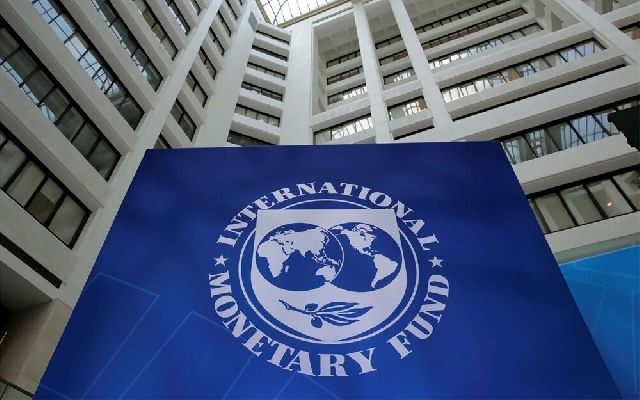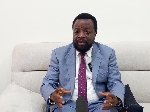US$3bn bailout: ‘Give Ghana necessary financing assurances as soon as possible’ – IMF tells China, Paris Club
 IMF
IMF
The International Monetary Fund (IMF) has urged Ghana’s creditors to hasten to grant the financing assurances needed promptly so the Board of the Bretton Woods institution can approve the cocoa, gold and oil-producing West African country’s $3-billion extended credit facility to restore economic stability to the nation.
“We're calling on bilateral creditors to support Ghana's effort to restore debt sustainability, form an official creditor committee, and deliver the necessary financing assurances as soon as possible”, the Fund’s communications director Julie Kozack told journalists at a news briefing in Washington DC.
A questioner has asked: “Ghana's president has said he expects the programme request to go to the IMF Board by the end of this month. Is that realistic? Can you give us an update on that?”
Ms Kozack answered: “So, on December 12th, 2022, the IMF reached a staff-level agreement with Ghana on a three-year programme supported by an arrangement under the ECF. This programme was worth about $3 billion”.
“Ghana also requested a debt treatment under the G20 Common Framework”, she noted.
She said: “Financing assurances from partners and creditors are necessary for presenting the programme request to the IMF's Executive Board for approval”, adding: “We continue to engage closely with the Ghanaian authorities while they seek these assurances”.
The IMF programme, Ms Kazack indicated, “aims to support Ghana's efforts to restore macroeconomic stability, debt sustainability while also protecting the vulnerable, preserving financial stability, and laying the foundation for strong and inclusive growth”.
A few weeks ago, President Nana Akufo-Addo said his government is “making progress on the external debt negotiations” with its development partners “since the government announced an external debt service suspension on 19th December 2022 for certain categories of external debt, to ensure an orderly restructuring”.
The suspension, the president told parliament in his state of the nation address on Wednesday, 8 March 2023, “is an interim emergency measure toward a comprehensive external debt operation which will contribute to the restoration of our debt sustainability in line with our request for a debt treatment under the G20 Common Framework”.
“I want to express our appreciation to the members of the Paris Club and to the Peoples’ Republic of China for the cooperation they have, so far, exhibited to us in attempting to reach an agreement, and in their attempt to establish an Official Credit Committee”.
“We look forward to their fast-tracking the needed financing assurances for IMF approval. We are confident that, with their cooperation, we will reach our March deadline for going to the Fund”, he said.
Already, the government has restructured its domestic debt and now seeking to replicate it on the international front in order to clinch an approval for a $3-billion extended credit facility from the Board of the IMF.
China debt talks ‘very positive’, ‘encouraging’ | Ofori-Atta ‘looking forward to securing external assurances very soon’
Meanwhile, Finance Minister Ken Ofori-Atta has said his meeting with China on Ghana’s external debt restructuring programme is has been very good so far.
Ghana is seeking debt forgiveness or restructuring of $1.7 billion owed China.
The external debt restructuring programme comes on the heels of a domestic one recently concluded by the government.
It is part of Ghana’s quest to secure a $3-billion extended credit facility from the International Monetary Fund.
Announcing progress of the talks with China, Mr Ken Ofori-Atta’s office tweeted: “So far had very positive and encouraging meetings in China! Looking forward to securing external assurances very soon, even as we pass our outstanding domestic revenue bills back home. Great progress on all fronts…#ResolvingTogether #GhanaFirst”.
So far had very positive and encouraging meetings in China! Looking forward to securing external assurances very soon, even as we pass our outstanding domestic revenue bills back home. Great progress on all fronts…#ResolvingTogether #GhanaFirst
— Office of the Finance Minister-Ghana (@oofmghana) March 24, 2023
In a related development, the IMF has advised African countries to take into consideration, the effects their debt restructuring programmes could have on the domestic banking sector.
At the 2023 Oxford Center for the Study of African Economies Conference at St Catherine’s College, Oxfordby, Mr Abebe Aemro Selassie Director, African Department of the IMF, said: "For cases where debt is unsustainable, it goes without saying that it needs to be restructured".
In such cases, he said "the burden of making repayments should not fall unduly on debtor countries".
"But this is easier said than done", he admitted, saying: "Debt restructurings have always been difficult, and even more so now in the context of a more diversified creditor base and more complex structure of public debt.
"Take domestic debt, which now accounts for about half of all public debt in sub-Saharan Africa.
"In cases where public debt is unsustainable and this exposure needs to be included in the restructuring perimeter, careful consideration needs to be given to the effects on the domestic banking sector, how quickly market access can be regained etc", he advised.
"And with respect to external creditors, countries of course have even less sway over the pace at which restructuring can happen, as clearly shown by the ongoing challenges with the Common Framework".
This, he noted, "is even more frustrating in unsustainable cases where the official creditors’ inability to agree on a needed debt treatment prevents the IMF from providing timely support to countries during periods of acute distress".
Read Mr Abebe Aemro Selassie's full remarks below:
Remarks at the 2023 Oxford Center for the Study of African Economies Conference by Abebe Aemro Selassie
Director, African Department of the IMF
St Catherine’s College, Oxford
March 20, 2023
Thank you very much for the opportunity to address you all this morning. And it’s good to do so in person this time, with the pandemic, for the most part, behind us,
To be clear though, the economic consequences of the pandemic continue to be felt acutely in most African countries. Unlike much of the rest of the world, these countries had limited ability to use fiscal and monetary policies to dampen its negative effects on their populations. And subsequent efforts to regain lost ground have been frustrated by the adverse external developments.
As we gather here, the region is facing a brutal financing squeeze. To be sure, this is not unique to African countries. But this region is the one that can least afford the implications of this squeeze, given Africa’s much-higher level of poverty and remaining development gaps.
In fact, my worry is that the current financing challenge is one that looks set to endure. And unfortunately, beyond the odd nod of the head here and there, this is not something that is being acted upon with the seriousness and urgency that it needs—either by the international community or the region’s policymakers. Certainly, awareness is not in line with the profound implications for our futures. And I dare say that it is not garnering much attention by the academic community.
If I sound a bit melodramatic it is because an obsession of mine is the belief that, one way or another, this will be the African Century. Africa is where I think much of the incremental global demand for investment and consumption will happen in the coming years—if only because the region is where all incremental global population growth is set to happen. A process well in-train.
In the rest of my remarks, I intend to expand on the financing challenge as I see it, and how best it can be navigated.
I. How Did We Get Here
I’d like to start with a story. And like most great stories, this one has a classic arc that can be organized into three acts.
Act 1: A newish beginning—in rough terms, 1990 to 2006 was a period of much market-friendly reforms, high volumes of aid flows, and an opening of political space. This engendered a marked pick-up in economic growth and significant improvements in development indicators.
Act 2: The price of success. I think it was Arvind Subramanian who once noted: growth begets more growth. And so it was that, as economic growth accelerated, confidence and investment opportunities increased. Debt relief from official and multilateral creditors under the Heavily Indebted and Poor Countries (HIPC) and Multilateral Debt Relief (MDRI) schemes made significant contributions. From the mid-2000s onwards, this was followed by quite a lot of financing flows to the region—from both official and private sources. And from the side of country authorities, the availability of increased financing made it possible to start addressing long-standing development needs. The consequence was a marked increase in the level of public debt in most countries in the region.
Act 3: The tide goes out. Thus, it was that, by 2015-16, many countries were already close to the edge. And few could have anticipated the scale of the shocks that were to follow. starting with the COVID-19 pandemic. The impact on the region’s funding outlook was immediate and devastating. Spreads widened sharply—more than twice the increase associated with the global financial crisis on 2008-09. Private portfolio inflows were quickly replaced by outflows, and in the face of urgent pandemic-related needs, many authorities found themselves without the finance to mount an adequate response. Indeed, in contrast to the extraordinary fiscal support seen across most advanced-market economies, Africa’s reaction to the crisis was much more constrained.
To be sure, some debt service payments to G20 bilateral official creditors were temporarily postponed under the Debt Service Suspension Initiative (DSSI). And both the World Bank and the IMF rapidly ramped up their concessional lending. Following the onset of the crisis, for example, the amount of finance provided to Africa by the IMF during 2020-21 amounted to over $70 billion, several multiples of the financing provided over the preceding 10 years. And these resources served as an important safety net for the region. Coupled with the agile and bold measures undertaken by the region’s leaders to contain the pandemic, these funds helped contain the greater damage that the pandemic would have otherwise wrought. But we are now at the point where this surge in support has dried up.
I have painted a rather linear picture of the complex and varied developments and processes that have got us here, with a lot of generalization. It is so that I can get to the conjuncture quickly.
II. What Exactly is the Problem?
Put simply, the region’s most pressing economic problem right now is the funding squeeze. This reflects several factors: loss of external market access after a brief post-pandemic respite and, indeed, capital flight from some countries; adverse effects of Russia’s invasion of Ukraine (particularly on food prices and fuel-importing countries); continued declines in official development assistance; and much lower flows from China and other new sources of financing. The domestic cost of funding has also gone up, limiting recourse to that alternative.
This is not just an immediate concern but can have lasting effects with implications for longer-term development. During the recent crisis—unlike major advanced economies—Africa had limited fiscal space, hampering policy makers’ ability to mount an effective response. With insufficient funding, authorities were less able to protect their most vulnerable, and were also forced to divert resources from critical development sectors such as health, education, and infrastructure, curtailing the region’s growth prospects. The crisis has never really passed, and the funding constraint persists.
We of course don’t know how the current squeeze will evolve. It could yet be the case that borrowing costs will attenuate and capital markets will once again become more benign, allowing countries, at a minimum, to rollover maturities falling due in coming years. But my sense is that the current difficult environment is likely to persist. Firstly, the global fight against inflation has been much more complicated than we had hoped, and tighter financial conditions will likely be with us for some time to come. Second, we are moving into a more volatile world—in which larger and larger shocks seem to be arriving more and more frequently. This has clear implications for risk premia and borrowing costs. But it also means that future flows, such as official assistance, may be somewhat less reliable.
The funding squeeze is all the more problematic because countries have emerged from the pandemic with elevated levels of fiscal deficits and public debt. Even if a country were to engineer a smooth return to a more normal fiscal position, the higher level of debt and higher borrowing costs (spreads over US treasuries) are more than double their pre-pandemic level—meaning that there are less resources for primary (non-interest) spending outlays. What I am trying to get at here is the difficulty that countries are facing in sustaining current levels of per-capita spending on health, education, infrastructure, much less increasing the spending required to meet the SDGs!
Our Managing Director, Kristalina Georgieva, always encourages us to hope for the best, but plan for the worst. In this vein, it is going to be very important for countries to carefully consider their funding mix. In a world where finance is cheap and easily replaced, the consequences of a particular decision can be contained. But we no longer live in that world. Resources have become scarce and more expensive. In this world, countries have to be more cautious about the type and composition of their financing, and they should be much more deliberate in mobilizing new resources.
III. Three Choices
To state the somewhat obvious, and simplifying things, a government’s ability to address development spending needs is bounded by the amount of revenues that it raises, its ability to supplement this by borrowing from either domestic or external markets, and any aid resources (grants and concessional borrowing) it has access to. Against this backdrop, and in the broadest of terms, there are three broad choices that governments face, and I will try and lay out the trade-offs next.
Choice 1. Public vs Private
Perhaps the most important choice in financing development is whether spending should be undertaken by the public or the private sector. In practice though, most African countries (and indeed elsewhere) tend to fund development largely through public finance. On average, some 79 percent of total government spending in sub-Saharan Africa is covered by revenues, a further 19 percent by borrowing, and 2 percent through grants and/or other concessional budget support. Needless to say, averages mask great heterogeneity across countries.
To be clear, the size of government is a deeply political and very country-specific issue. And given the important externalities involved in public spending in health, education, and much large-scale infrastructure—coupled with limited private sector capacity--government provision of such services is very appropriate. The challenge for governments is that with borrowing space limited (see below) and aid flows highly circumscribed, the only way to make more room is through domestic revenue mobilization.
There are though many challenges on this front. Take developments over the last 10 or so years. African countries have done much to invest in human capital and improve public infrastructure. But for political and technical reasons, they have found it very difficult to capture the returns on this investment through their tax systems. Hence, the ratio of interest payments on debt to revenues has continued to drift upwards in country after country—with the median doubling to 10 percent in just a decade—leading to the debt difficulties that we are now seeing in some countries in the region. In general, cross-country experience shows that countries can at most generate between ½ and 1 percent of GDP in additional revenues per year. Given the need to reduce still-elevated fiscal deficits to more sustainable levels in the next few years, much additional revenue mobilization in the near-term is, I fear, likely to be devoted to reducing fiscal deficits rather than making space for incremental spending.
This makes it important to consider what role private finance could play in supporting development in the region—much as has been the case in Asia.
At the moment, the private sector plays a somewhat limited development role—public entities carry out 95 percent of infrastructure projects in the region, and despite the continent’s clear potential, Africa attracts only 2 percent of global foreign direct investment. Further, when investment does go to Africa, it is predominantly in natural resources and extractive industries, much less so, health, roads, or water.
To attract private investors and transform the way Africa finances its development, an improved business environment is critical.
But that is not enough.
Even in the most favorable environments, development sectors are special in a way that often complicates private sector participation. For instance, infrastructure projects often have large upfront costs, but returns accrue only over long periods of time, which can be difficult for private investors to assess. Private sector growth also thrives on networks and value chains, which may not yet exist in new markets.
When these problems are acute, governments may need to provide extra incentives. And these can sometimes be costly. But the truth is, many projects in development sectors simply won’t happen without them. In East Asia, 90 percent of infrastructure projects with private participation receive some government support.
Now, there are ways in which governments can maximize impact while minimizing risks and costs. For example, support should be targeted, temporary, and granted on the basis of clear market failures. It should also be transparent, leave private parties with sufficient skin in the game, and should focus tightly on worthy projects that would not happen otherwise.
With this in mind, African countries and their development partners might consider reallocating some resources towards public incentives for private projects. Underpinned by sound governance and transparency, a more innovative private-sector approach may significantly increase the amount, range, and quality of services for people in Africa.
Choice 2. Domestic vs External
Another important choice is whether development spending should be financed with domestic or foreign funds. As just noted, for the most part, countries finance themselves from domestic resources. But at the margin, foreign flows, particularly borrowed resources, contribute meaningfully to government finances. And beyond just bridging the fiscal funding gap, external borrowing helps reduce the large current account deficits that are typical during the early stages of development. To put it another way, external flows punch well above their weight.
And in recent years, recourse to external borrowing in sub-Saharan Africa has been significant. For one, the global economic and financial environment was conducive—and following the large debt relief of the HIPC/MDRI it was believed that market borrowing would help instill discipline. And with low domestic savings and limited financial markets, for many countries in the region it was the only meaningful way to raise the resources needed to increase development spending. But with funding costs having increased markedly for all countries, and set to remain that way, this source of funding is going to be a less and less likely option. For example, since Russia’s invasion of Ukraine and the upheaval in capital markets it unleashed, no sub-Saharan country has been able to issue a Eurobond.
This leaves domestic savings. Of course, the need to foster more domestic savings has long been understood as the kernel of economic development. Some 70 years ago, Arthur Lewis noted. The central problem in the theory of economic development is to understand the process by which a community which was previously saving and investing 4 or 5 per cent of its national income, converts itself into an economy where voluntary saving is running at about 12 to 15 per cent of national income…We cannot explain any ‘industrial’ revolution until we can explain why saving increased relatively to national income.
There is a large and still unresolved literature that seeks to explain why some countries save more than others. Demographics seem to play a role. But also, many other factors.
At the IMF—with an eye on generating practical policy options—we have been paying close attention to the role of domestic financial systems. A poorly developed system, with low inclusion, ineffective regulation or supervision, few options, limited competition, and constrained deposit rates will generally do poorly in mobilizing domestic savings and channeling those savings to people who can use them most productively.
Moreover, the challenge in Africa is particularly complicated by the fact that a large portion of economic activity is in the informal sector, where much of the population remains unbanked and where savings are kept as non-financial assets such as livestock, goods, grain, or other materials. These resources are not deposited in savings accounts or other formal financial channels and so are unavailable for investment. This is why at the Fund we have made a growing focus on financial inclusion. Not only does inclusion provide greater opportunities to some of the region’s most vulnerable, but it can also help our countries tap into an underused pool of savings, placing them in a better position to meet more of their own development needs locally. But like revenue mobilization this too of course is a gradual process
Choice 3. Concessional vs non-Concessional Borrowing
Within the envelope of external financing, a further important option for financing development concerns the mix between concessional and non-concessional funding. Concessional resources are a sizeable component of external flows—representing around a quarter to a third of external flows for the region as a whole. And with few countries able to take on significantly more debt at market rates, going forward the need for concessional financing is more critical than ever.
To my mind, Africa’s progress over the past couple of decades—across all development metrics—has been nothing short of remarkable. Improvements in life expectancy, literacy, health outcomes, access to education, etc have all profoundly reshaped the continent. This was made possible by three important factors:
• Far-reaching reforms by countries to considerably improve public finances, the quality of institutions, and the business environment;
• A highly supportive global environment, with countries benefitting from strong growth in trading partners, favorable global financial conditions, and growing exposure to a surging Chinese economy; and
• Much support from the international community, starting with debt relief initially and followed by significant concessional budget support, particularly up to around 2009-10.
Of course, aid flows have over the years been declining.[1] But because this could be offset by non-concessional financing in many countries, its adverse effects have been limited. However, the lower level of concessional financing is now going to be felt more as alternative sources of financing have dried up.
But to note: lower aid/concessional financing flows have still had considerable adverse effects. Almost always, lower aid flows mean lower fiscal space. As aid flows have declined over the years and been replaced by more expensive financing, the effect has been to increase countries’ weighted average cost of financing, while also making them more exposed to shifting market sentiment.
IV. Debt Restructuring
You must be wondering why I am leaving out another important avenue to create fiscal space in countries—debt restructuring.
I wanted to get to this last as a bit of an antidote to the rather pervasive narrative out there that the region’s main challenge is too much debt, particularly to China. Yes, high indebtedness is a major problem in some countries and debt vulnerabilities have generally increased. But in most other cases public debt is elevated but still manageable. And, yes, while China is an important creditor to some countries, in most cases debt to China is modest. Note public debt to China accounts for around 8 percent of total sub-Saharan Africa public debt. Hence the problem is much broader. From a region-wide perspective, it is the funding squeeze that matters most—it threatens to push even those countries with manageable debt positions into insolvency.
For cases where debt is unsustainable, it goes without saying that it needs to be restructured. In such cases, the burden of making repayments should not fall unduly on debtor countries. But this is easier said than done. Debt restructurings have always been difficult, and even more so now in the context of a more diversified creditor base and more complex structure of public debt. Take domestic debt, which now accounts for about half of all public debt in sub-Saharan Africa. In cases where public debt is unsustainable and this exposure needs to be included in the restructuring perimeter, careful consideration needs to be given to the effects on the domestic banking sector, how quickly market access can be regained etc. And with respect to external creditors, countries of course have even less sway over the pace at which restructuring can happen, as clearly shown by the ongoing challenges with the Common Framework. This is even more frustrating in unsustainable cases where the official creditors’ inability to agree on a needed debt treatment prevents the IMF from providing timely support to countries during periods of acute distress.
V. Some Takeaways
Forgive me if I have been a bit too glum.
My optimism about the region’s prospects remains undiminished. As difficult as conditions are at the moment, I strongly believe that the vast majority of countries have reached a threshold where even in the face of the many challenges they face, they will get by; indeed, go on to prosper. Rather, what is frustrating is that with a modicum of increased support, the region could be helped to reach its full potential sooner and the global economy could be much better for it.
While countries have a clear role to play, what is required of the international community going forward are the following:
• Much higher volumes of countercyclical flows, particularly from International Financial Institutions (IFIs), to neutralize the highly procyclical nature of private capital flows. At the Fund, for example, right now our ability to sustain our recent high levels of support is increasingly being constrained by the limited availability of concessional resources. A challenge that we are working very hard to address via pledges from our wealthier members.
• A more agile and effective sovereign debt resolution framework. The G20’s Common Framework is an important innovation, and we would be in a much worse place without it. At the same time, it has not been able to provide the required financing assurances and debt relief in a timely manner. This needs to change, and quickly. Again, as an institution, we are working relentlessly to improve this process and, with the World Bank and the G20, launched a new Global Sovereign Debt Roundtable in February to bring together key stakeholders involved in sovereign debt restructuring to address the current shortcomings in debt restructurings.
• Finally, more support from advanced countries is needed. As one British mandarin once put it to me, the “authorizing environment” for this is not exactly favorable. Indeed, we are seeing significant cuts in such flows, and a significant share of what is not being cut is instead being directed elsewhere. Two quick points on this. First, as the preceding discussion has, I hope, convinced you, this cut in aid, particularly its diversion away from budgets, is having the very significant effect of proportionally reducing development spending. Second, if it is perhaps too much to ask for higher aid, then one change that could at least be made is to ensure that there is much more progressivity in aid flows to the poorest and more fragile countries.
Again, absent making sure that we devote the resources needed now to build human capital and help integrate Africa into the global economy, it is not just slower growth and development progress in the region that is in store, but also a much weaker and less resilient global economy.
Thank you so much for your attention.
______________
[1] From a peak of around 6 percent of recipient country GDP in the 1990s, aid flows so sub-Saharan Africa now average only 2½ percent. Moreover, increasingly, such aid flows are no longer in the form of budget support.
Source: Classfmonline.com
Trending News

Ex-workers accuse Heath Goldfields of repeatedly shifting payment timelines
14:02
Traditional spiritual overlords demand national recognition
14:02
Violence is the only way to settle issues in Parliament-Minority
13:46
Dr. Boris Baidoo announces approved farm and retail egg prices
13:04
Finance Minister orders strict enforcement of 2024 audit report recommendations
15:02
Sam George commends Cyber Security Authority for successful strike against cyber fraud
12:46
Cocobod board chair calls for stronger security collaboration to tackle Cocoa and farm input smuggling
12:52
Western Region intensifies fight against illegal mining; Changfang machines targeted for total removal
13:31
West Africa on alert as ECOWAS announces state of emergency
13:01
‘This is the real picture’:Dr. Kpikpi says 2024 WASSCE reflects long-standing decline
14:06



